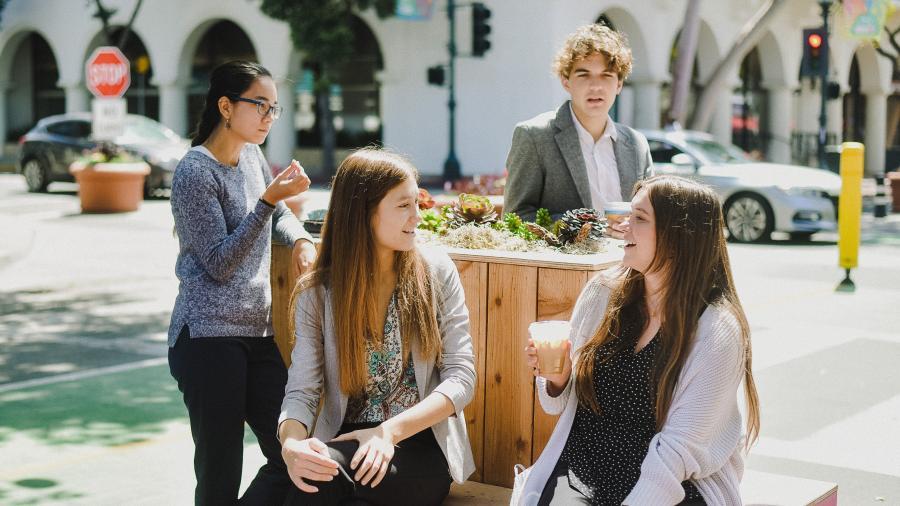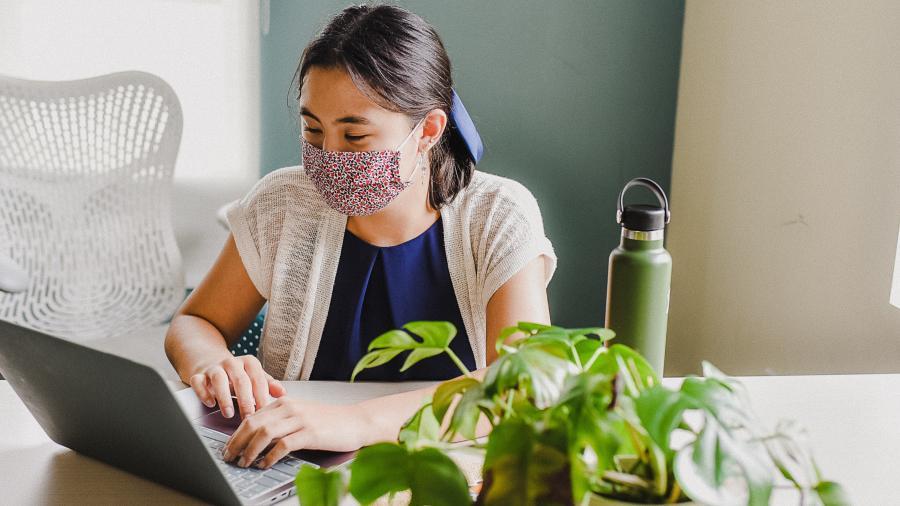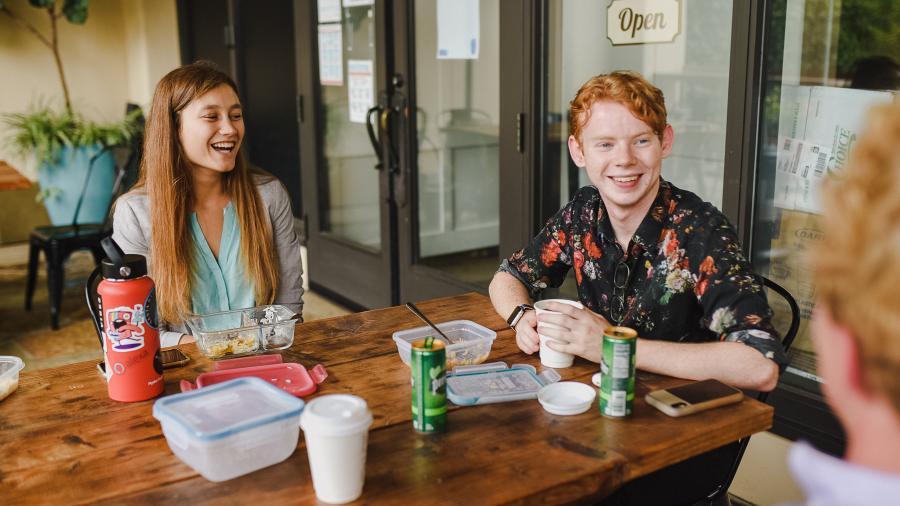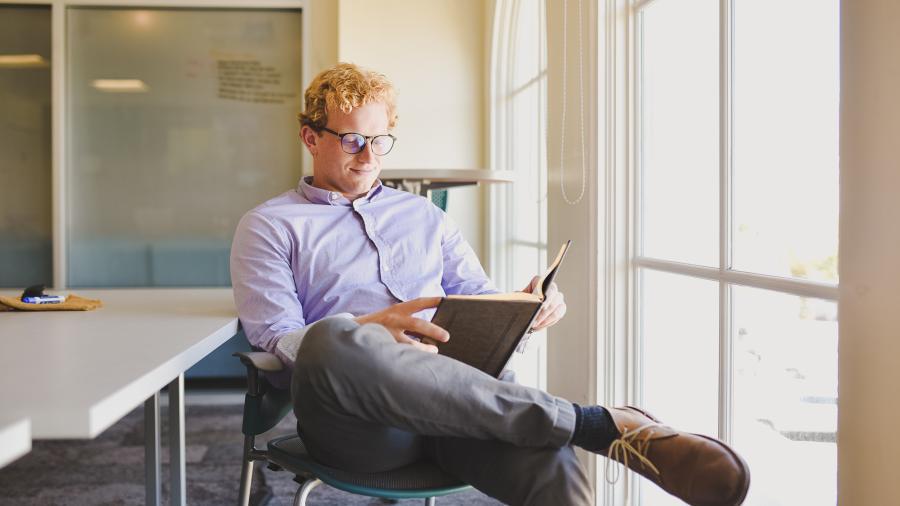How We Stay Grounded

So much of our lives—and especially our work!—is spent in front of the computer. It can be easy to get caught up in tasks or to let the fact that we can work from anywhere make us feel obligated to work from everywhere. To counteract the tendency to get caught up in work or technology, a few of our CATLab members shared how they stay grounded.
Consider physical space
When several members of our team were asked how they maintain a healthy work-life balance, the first thing everyone mentioned was the space. Here at the Westmont Downtown office, we’re blessed with an open floor plan that invites people to wander in and out as they need. More than that, however, we also make a habit of leaving our doors open and only shutting them to contain noise if someone’s in a meeting or artistic reverie. Ben, one of our analysts, said he appreciates “not having very sectioned off spaces” because it encourages him to move around, talk to others, and seek help when he gets stuck. Another analyst, Josh, said he appreciated the “duality of structure and flexibility” in our office. Kenna, who manages the CATLab’s communications, also mentioned how the creative team has put in special effort to make the space our own: “We put plants at the tables, we put up signs, we named our rooms after Salesforce characters—things that just kind of add a personal element to the place that we’re in every day.”
Get to know the people and places immediately around you
In a digital age, when we can instantaneously connect with someone on the other side of the world, it can be all too easy to forget the people who are right next to us. At the CATLab, we value connecting with each other as whole people, not simply coworkers. Kenna shared that she enjoys finding someone to take her 15-minute break with so she can grab coffee and connect with them:
“Getting to know someone makes you want to root for them and support them, and vice versa. I think that also allows you to build relationships in the workplace that make you feel more at home because you’re more comfortable with the people you’re with.”
Several of our teammates regularly have lunch together in a courtyard just across the block from our office. Both Kenna and Josh shared that they enjoyed this space to connect with other CATLab people in a non-work context. Also, because our office is helpfully “embedded in the center of Santa Barbara,” we have the opportunity to build connections with the local community.
Plan your priorities
Josh shared that it’s very important for him to have “a firm expectation of what’s in store” for any given day. Although plans may change, having a “game plan” in place helps him know “how to prioritize my time, how to allocate my resources, and whatnot.” While plenty of us may commend the power of a planner for accomplishing tasks or schoolwork, something unique Josh emphasized was that he also finds the need to be intentional about “making sure that you have enough time allocated to things that are life-giving.” Without “planning that out in a very explicit way,” Josh says, “it’s hard for me to be able to make that firm distinction between what’s work and what’s my time.”
One way we did this as a whole team was when we took a morning to attend the Salesforce Higher Ed Summit. Even though this was part of work, there was no expectation to make progress on deliverables for a few hours—just a time dedicated to recentering on the purpose of our work within the larger mission of higher education. Munching on some donuts, we watched inspiring speeches and stories and enjoyed putting our work back in perspective.
Go for a walk
A great way to take a break both physically and mentally is by leaving the desk entirely and taking a walk. This could be as involved as organizing a team hike, but it doesn’t have to be. Even a short stroll around the office during a 15-minute break “does wonders for the soul,” as Kenna put it. What’s especially lifegiving for her is “touching nature and smelling flowers and being fully immersed in that moment.” Sometimes she picks small bouquets and gives them as gifts to people:
“It’s a fun and unusual way to bless people in their days, and it makes me feel blessed too!”
Taking the time to step away from screens and stretch our muscles as an act of caring for ourselves serves as a reminder that we are more than just the work of our brains: We are fully embodied people whose worth is not dependent on our productivity.
Build in bookends to your workday
For Ben, one way to hold onto perspective and create a healthy boundary between work and life has been to bookend his workday with activities that signal a shift in both his mind and body. Ben likes to wake up early and have some time to himself to be quiet in the mornings. Then, “towards the end of the day,” he likes “finding ways to be active, whether that’s surfing, going on a run, working out.” Putting these activities before and after his time in the office means that he can think more holistically about his time, not getting too caught up in work:
“Having those two things on either side of the day really helps me to stay grounded and not get worried about things I don’t need to be worried about.”
This idea of building in set-apart time right at the beginning of the day happens within the CATLab as well: We set aside the first half hour of the morning to settle in for the day, catch up with each other, talk through the schedule, and read some Scripture and prayers together. The CATLab makes an effort to support its members not just as coders or content creators, but as whole people.
Related Reading:
- In Tension with Intention: The Divide Between Humanity and Technology
- Rethinking Habit: Intentional Practices as Embodied Humans in a Digital World
- How to Create a Culture of Collaboration
For more advice and insights from our team, follow us!




